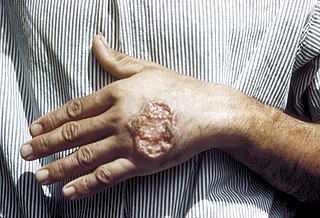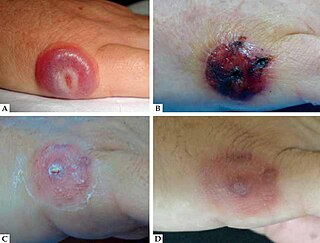Related Research Articles

Leishmaniasis is a wide array of clinical manifestations caused by protozoal parasites of the Trypanosomatida genus Leishmania. It is generally spread through the bite of phlebotomine sandflies, Phlebotomus and Lutzomyia, and occurs most frequently in the tropics and sub-tropics of Africa, Asia, the Americas, and southern Europe. The disease can present in three main ways: cutaneous, mucocutaneous, or visceral. The cutaneous form presents with skin ulcers, while the mucocutaneous form presents with ulcers of the skin, mouth, and nose. The visceral form starts with skin ulcers and later presents with fever, low red blood cell count, and enlarged spleen and liver.

Lichen planus (LP) is a chronic inflammatory and autoimmune disease that affects the skin, nails, hair, and mucous membranes. It is not an actual lichen, but is named for its appearance. It is characterized by polygonal, flat-topped, violaceous papules and plaques with overlying, reticulated, fine white scale, commonly affecting dorsal hands, flexural wrists and forearms, trunk, anterior lower legs and oral mucosa. The hue may be gray-brown in people with darker skin. Although there is a broad clinical range of LP manifestations, the skin and oral cavity remain as the major sites of involvement. The cause is unknown, but it is thought to be the result of an autoimmune process with an unknown initial trigger. There is no cure, but many different medications and procedures have been used in efforts to control the symptoms.

A blue nevus is a type of coloured mole, typically a single well-defined blue-black bump.
Juvenile plantar dermatosis is a condition usually seen in children between the ages of 3 and 14, and involves the cracking and peeling of weight bearing areas of the soles of the feet. One of the earliest descriptions was made by British dermatologist Darrell Wilkinson.

Cutaneous small-vessel vasculitis (CSVV), is inflammation of small blood vessels, usually accompanied by small lumps beneath the skin. The condition is also known as hypersensitivity vasculitis, cutaneous leukocytoclastic vasculitis, hypersensitivity angiitis, cutaneous leukocytoclastic angiitis, cutaneous necrotizing vasculitis and cutaneous necrotizing venulitis,
Black heel and palm is a skin condition characterized by a sudden shower of minute, black, punctate macules occurring most often on the posterior edge of the plantar surface of one or both heels.

Piezogenic papules are protrusions of fat that form within the subcutaneous tissue of the skin. They are typically found on the heels or wrists.
Cutaneous actinomycosis is a chronic disease that affects the deep subcutaneous tissue of the skin. Caused by an anaerobic, Gram-positive, filamentous type of bacteria in the genus Actinomyces, invasion of the soft tissue leads to the formation of abnormal channels leading to the skin surface that discharge pale yellow sulfur granules.

Milker's nodules are a cutaneous condition that is most commonly transmitted from the udders of infected cows. Milker's nodule is caused by Paravaccinia virus. The disease in humans is nearly identical to Orf.

Cutaneous lymphoid hyperplasia refers to a groups of benign cutaneous disorders characterized by collections of lymphocytes, macrophages, and dendritic cells in the skin. Conditions included in this groups are:

Bazex–Dupré–Christol syndrome is a very rare condition inherited in an X-linked dominant fashion. Physical findings typically include follicular atrophoderma, multiple basal cell carcinomas, hypotrichosis, and hypohidrosis.
Surfer's knots are a cutaneous condition caused by chronic pressure over bony prominences leading to thick fibrotic nodules on knees, knuckles, dorsal feet, often seen with those who perform surfing, boxing, football, and marbles.
Runner's rump is a cutaneous condition characterized by a small ecchymoses in upper gluteal cleft caused by constant friction with each stride when running.
Flea-borne spotted fever or California pseudotyphus is a condition characterized by a rash of maculopapules or furuncles.
Tulip fingers are a cutaneous condition, a combined allergic and irritant contact dermatitis caused by contact with tulip bulbs.
Sebaceous nevus syndrome is a cutaneous condition and may resemble CHILD syndrome.
Skin pop scars are a cutaneous condition caused by intravenous drug abuse.
Pinch marks are a cutaneous condition caused by pinching, and when on the ears or in the genital region of male children may be suggestive of child abuse.
Loop marks are a cutaneous condition, caused by beating with a doubled-over cord. They are perhaps the single most characteristic finding in child abuse.

Sarcoidosis, an inflammatory disease, involves the skin in about 25% of patients. The most common lesions are erythema nodosum, plaques, maculopapular eruptions, subcutaneous nodules, and lupus pernio. Treatment is not required, since the lesions usually resolve spontaneously in two to four weeks. Although it may be disfiguring, cutaneous sarcoidosis rarely causes major problems.
References
- ↑ Rapini, Ronald P.; Bolognia, Jean L.; Jorizzo, Joseph L. (2007). Dermatology: 2-Volume Set. St. Louis: Mosby. ISBN 978-1-4160-2999-1.
- ↑ Perry, Shannon E. (2016). Maternal Child Nursing Care in Canada - E-Book. Elsevier Health Sciences. p. 700. ISBN 9781771720830 . Retrieved 18 January 2018.